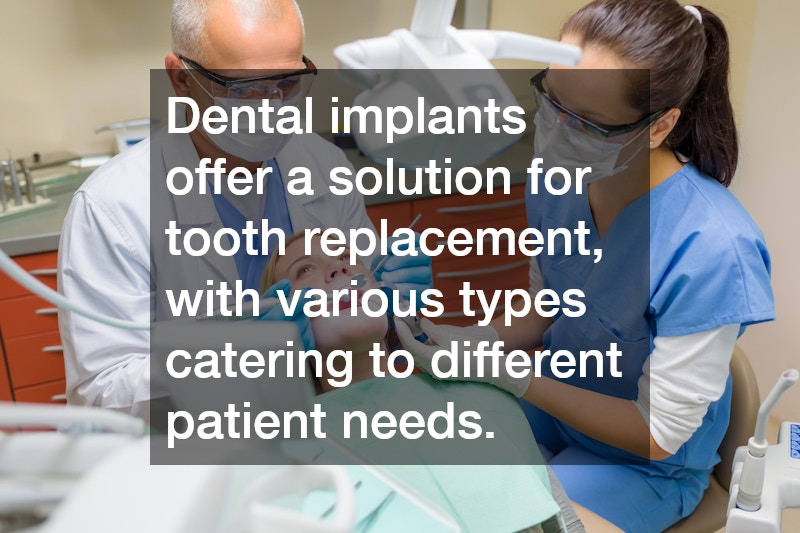What Are the Types of Dental Implants and Which Option Is Right for You

What Are the Types of Dental Implants and Which Option Is Right for You?
In the realm of modern dentistry, dental implants have emerged as a revolutionary solution to tooth loss, offering patients a durable and aesthetically pleasing replacement. This article aims to educate readers on the different types of dental implants available, as well as offer guidance on selecting the most suitable option based on individual needs.
What Are the Main Types of Dental Implants?
Endosteal Implants
Endosteal implants are the most common type of dental implant, which are typically shaped like small screws and are surgically placed into the jawbone. These implants offer numerous benefits, including a high success rate and the ability to support various dental prosthetics, making them a popular choice for many patients.
The procedure for endosteal implants involves two stages: first, the implant is placed into the jawbone, and then a healing period allows for osseointegration, during which the implant fuses with the bone. After this integration, an abutment is attached, which acts as a connector between the implant and the artificial tooth.
Despite their advantages, endosteal implants require sufficient bone density in the jaw to be effective. Patients with inadequate bone levels might need bone grafting procedures before receiving this type of implant, highlighting the importance of professional consultation to determine suitability.
Subperiosteal Implants
Subperiosteal implants differ from endosteal implants by resting on top of the jawbone rather than being implanted within it. These implants are held in place by a metal framework that protrudes through the gum to support a dental prosthesis.
One unique feature of subperiosteal implants is their suitability for patients who have experienced significant bone loss and lack the necessary bone mass required for endosteal implants. This makes them an advantageous option for individuals who want to avoid bone grafting procedures.
Ultimately, the choice between endosteal and subperiosteal implants should be made after a thorough assessment by a dental professional. This ensures that the chosen implant type effectively addresses the patient’s specific dental needs and conditions.
How Do You Choose the Right Dental Implant?
Consultation and Assessment
A thorough dental consultation is crucial in determining the most appropriate type of dental implant for a patient. During this process, dental professionals evaluate various factors such as bone density, gum health, and overall oral hygiene.
Assessments may include a comprehensive examination, dental radiographs, and 3D imaging to assess the jawbone’s suitability for implant placement. This thorough analysis helps identify the implant type that will provide the best functional and aesthetic outcomes.
In addition to considering the physical aspects of a patient’s dental health, a dentist might also take into account factors such as the patient’s expectations and lifestyle. These considerations play a pivotal role in tailoring a personalized treatment plan.
Personal Considerations
Choosing the right dental implant goes beyond clinical factors; personal considerations such as lifestyle and budget are equally impactful. Patients with active lifestyles may prioritize implants that offer durability and reliability over the long term.
Individuals must consider their financial situation as dental implant procedures can be costly, and insurance policies might not cover all expenses. Therefore, discussing financial concerns with the dental team can help in choosing a cost-effective option that aligns with the patient’s means.
Health conditions such as diabetes or osteoporosis can influence the healing process and overall implant success. As a result, a holistic evaluation of health conditions is essential, focusing on how they might impact the suitability and longevity of the chosen implant.
What Are the Success Rates and Risks Associated with Dental Implants?
Success Rates
Dental implants are well-regarded for their high success rates, which often exceed 95% in healthy patients with proper aftercare. The success of implants depends heavily on factors like the quality of the bone, the patient’s overall health, and the experience of the dental surgeon.
Research consistently indicates that with adequate maintenance and oral hygiene practices, dental implants can last several decades, serving as a reliable long-term solution for tooth replacement. The type of implant and its specific application also play a role in achieving high success rates.
By addressing potential issues such as smoking or uncontrolled diabetes before the implant procedure, patients can further enhance the likelihood of success. Such preparative measures are essential in fostering favorable outcomes and extending the longevity of the implants.
Potential Risks and Complications
Despite their high success rates, dental implants, like any medical procedure, do pose certain risks and complications. Common issues include infection at the implant site, injury to surrounding teeth or blood vessels, and improper implant placement.
Post-procedural care plays a vital role in minimizing these risks, with patients often advised to maintain good oral hygiene and attend regular check-ups. Addressing any issues early can prevent complications from escalating and ensure the stability and functionality of the implant over time.
In some cases, patients might experience bone loss or implant failure in the long term, necessitating additional treatment or implant removal. This reaffirms the importance of careful planning, expertise of the dental team, and active patient participation in ensuring successful outcomes.
Conclusion
In conclusion, dental implants offer an effective solution for tooth replacement, with various types catering to different patient needs. By understanding the distinctions between endosteal and subperiosteal implants and considering both clinical and personal factors, patients can make informed decisions.
While the high success rates of dental implants are encouraging, potential risks underscore the importance of choosing an experienced dental practitioner and adhering to recommended post-care practices. Taking these factors into account leads to successful implant integration and longstanding oral health improvements.
Readers are encouraged to seek professional dental advice to explore available options and determine the best implant type tailored to their specific requirements. Such informed decision-making is crucial in achieving satisfactory and long-lasting dental solutions.






